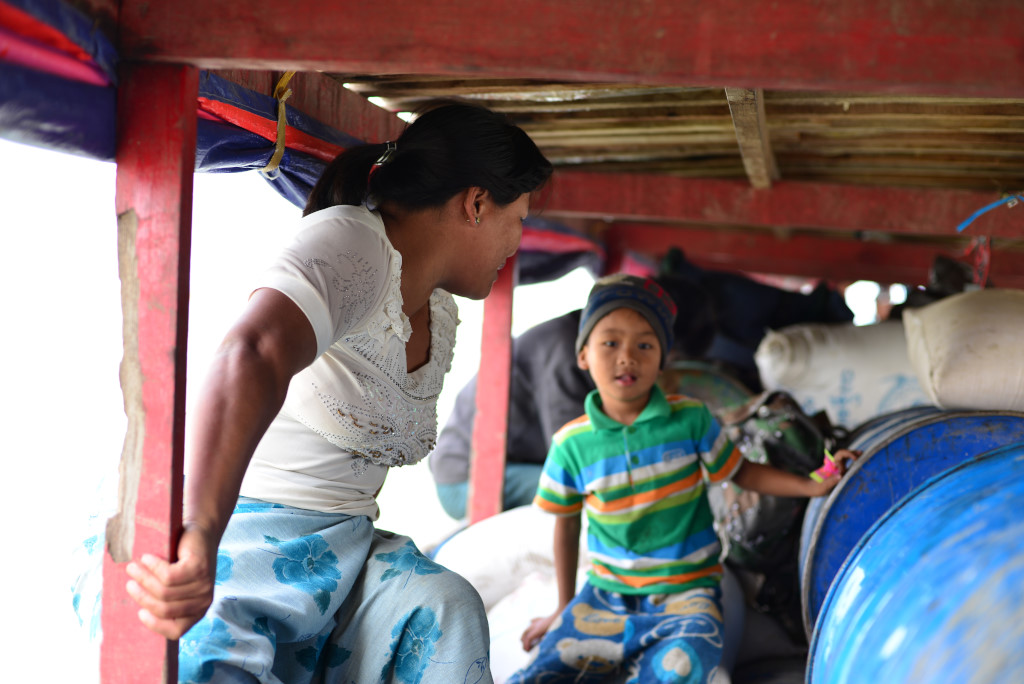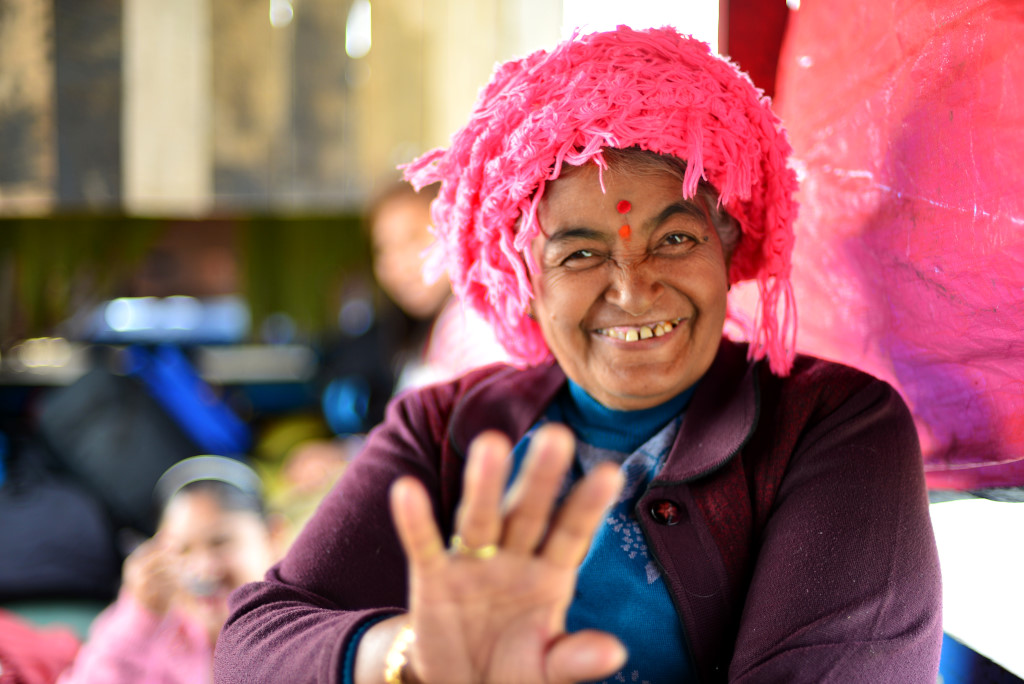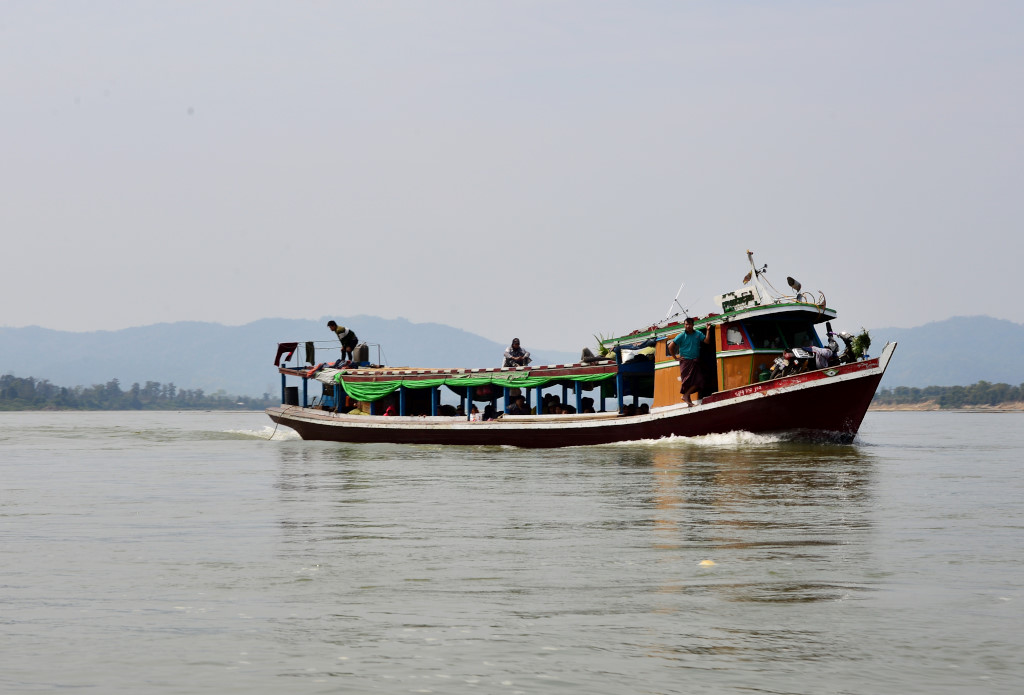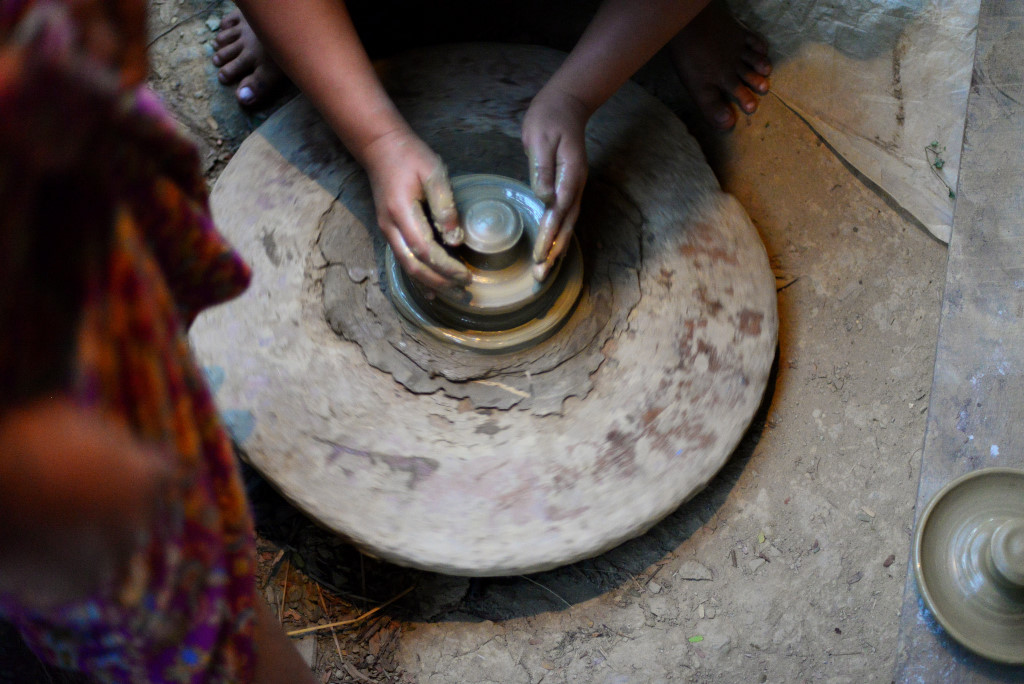February 22nd, 2015

Beholding the longboats moored amongst the rotting garbage on the riverbank and the young touts chiding each other, I look for anyone who looks vaguely credible and recite the text I procured from the Paradise Hotel “Where is the boat to Shwegu?” They point to the boat immediately to my right. I repeat the question to people standing next to the boat and they confirm that this is indeed the boat.

There are only a few people seated on the boat, and despite being motioned to board the boat, I stand still, with the curious premonition that the boat may not be leaving for quite some time. I climb into the boat and seat myself, nothing happening for quite a while. A large group of Indo-Burmese women board, then more waiting. The captain comes by and takes one look at me, telling me in Burmese what I presume to be that I can’t take the speedboat. No, no, not allowed, he insists, but I admonish him in return – at the hotel they told me repeatedly I could go – I asked about this specifically again and again. Why would they have told me that if it wasn’t the case?

He gives up, not wanting to bother with the argument, although I should also keep a low profile on the boat in case some immigration official wanders by, which hopefully should be less likely, given that it is Sunday. Tellingly, all passengers seem to be issued tickets except me. A motorcycle truck descends towards the water, unloading 15 battered metal barrels, and then it crystallizes that the captain will in fact wait until the boat is loaded to the gills before departure – and the locals probably know that the boats don’t in fact leave until much later, hence take their time to get here.

It would have been nice if I had actually been told that much at the hotel as I could have made much more of the morning. Now a plank is rolled against the edge of the boat, three men from the delivery truck rolling the barrels upward, the boat captain and his assistant letting the barrel drop onto a tire, then sliding it into place. One after the other, the systematic moving of these barrels continues until all are in place – although who knows how they will get them out of the boat! More passengers arrive, and yet there is still space towards the stern, and I wouldn’t be surprised that they are waiting to fill that too.

Now another truck arrives, this time a herd of pigs carried squealing in ear-splitting panic towards the boat’s hold, where they become quiet the moment they are on their feet again. And over 2 ½ hours after I arrived at the shore of the river, the driver mounts into the cabin above, the captain boards, the engine revs up, and we ease our way slowly into the channel.

The boat proceeds very cautiously, contending with the eddies, shallow waters and other boat traffic weaving through. We emerge from the channel Bhamo is situated on into the now broad Irrawaddy, the women in front of me nervously pointing at the water trickling along the inside of the prow. I am not sure if this is much of a problem, considering that as heavily loaded as the boat may be, we still clear the water by some amount – and then we are on a relatively slow-moving river with graduated banks, so escaping couldn’t be such a crisis in the worst case scenario.

The sandy banks of the river back on to a flat and uninteresting landscape, the sun now beating down on us as we reach a moderate cruising speed, the breeze cool, and the women before me engrossed in chatter that will keep them occupied for the bulk of the trip.

Behind me is a woman with young boy of at most four, precocious to the extreme, singing, chanting, gesticulating wildly, miming, the procession of outlandish and impromptu theatricality relentless, over the span of the entire trip. Mostly the mother is very patient and engages him, but sometimes just watches the obviously brilliant child impassively, others embracing her radiant child with touching fervour, and others yet admonishing him as he becomes too erratic. The few occasions I laugh and take photos of him provide yet another opportunity for wildly imaginative cavorting. I may not speak any Burmese, but the child is also incredibly articulate in his presentation. Whatever becomes of this child, I hope his incredible talents aren’t wasted …

Closer to Bhamo, boats of comparable length and girth pass us by, loaded down with merchandise, or simply berthed by the opposing river bank, lungyi-clad men crouch on the decks, watching us pass. The sandy shores continue for some distance, ideal for sunbathing, if Burmese were inclined to want to darken even more.
One of the female group seated ahead of me speaks reasonably good English, and tells me that they are friends from Bhamo on a visit to Shwegu, although they don’t seem to be too interested in the now more dramatic landscape, lush hills rising above the riverbanks with small atmospheric shacks occasionally dotting the shoreline.

She is a dairy farmer in Bhamo, and confirms that yes, the Burmese like their milk, having inherited the tradition of sweetened milky tea from the British. Of the few crops I see growing along the shoreline, corn seems to be dominant. I spot what look like the official government ferry several times, but then they are only supposed to be running several times a week. Perhaps further downstream they run more often? Other than just being tired, I find the trip to be very comfortable and would have been even more fun if I could speak some Burmese, as it provides another great opportunity to get close to local people.

We come upon a section with a modern steel bridge, an anomaly in this empty region with virtually no settlements. And yet before us lies one, a 10 minute stop offering us the delights of a row of stands set on the steep slope above us. We must be near Shwegu at this point, although one of the smiling women assures me that we are really only halfway.

I follow the rest of our party to enjoy the selection of alcoholic and soft drinks, sweets, snacks, some fresh foods that don’t seem very inviting, and in any case, there is little time to decide, as we are called back by the impatient boat captain. I take away a small baggie of what I think are smoked bananas, although the charred taste and seeds inside compel me to think that it may be some other fruit – wild bananas?

And I still need to go to the toilet, although I doubt I could just pee behind the banyan at the top of the slope as the village seems to begin there. Not that as the lone Caucasian within 100 kilometres of here I won’t be the target of everyone’s attention to begin with. From the slope I see that there is an entire set of passengers sitting on the roof of the boat that I hadn’t seen before, mostly swaddled in heavy jackets, the temperatures probably freezing for the Burmese, and also traveling with large amounts of bundled merchandise.

We continue to the other riverbank, where a party of bathing women gets into an altercation with a strapping young man, then we continue downriver into the growing haze, the temperature dropping as the afternoon progresses. The large female party fastidiously continues chewing sunflower seeds, probably bored out of their minds, eager to finally disembark.

The river weaves along, from wide sections to narrow passages, a collection of wooden shacks here, another on another bank, the lush forest rising up from the banks on the sometime steep hills that flank the river, the views always dramatic, with virtually no people in sight. It seems amazing that such large tracts of this river would seem entirely empty, as it is the central artery of this country. Lone fisherman troll for fish, and a few tiny golden stupas crest some rocks underneath one towering cliff. My neighboring passengers eagerly point out the face of a bird that has been painted onto a prominent angled rocky outcropping.

Several passengers point to the collection of shacks lining the raised embankment while uttering ‘Shwegu’. I guess I could act stupid and ask people repeatedly if this was it, but the fact that passengers are now collecting their belongings and standing up, ready to disembark as we approach the shore makes matters fairly clear. Disembarking is a bit precarious, given that you have to climb off the lip of the boat and drag yourself to the top of a stone ledge, although this doesn’t seem to dissuade the crowd of older local women who came for a visit. Hopefully someone will be on hand to grab my backpacks as I toss them up the ledge before I haul myself off the boat.

Now the boat captain is all smiles, happy that I liked the trip, and even happier that I paid him his $5 fare. This certainly doesn’t look like the most memorable place, judging from what can be seen along the shore, although further up the embankment, traffic is visible on the main road, in addition to stone house fronts. Crimson-clad monks and soldiers mill around the pier, a great Burmese combination, but no one says anything about the fact that I shouldn’t have taken the speedboat. The taxi drivers randomly approach me to take me to a hotel, but wander off when my response is neither positive nor negative.

The mother of the boisterous young son is now seated sedately on a table near the crest of the slope, an older man next to her showing me some of old Burmese 10 kyat bills with Aung San’s face on it. He hands me a few to take with me – no, they’re valuable if they’re old – why give them away?
I make the mistake of showing him my travel guide and pointing to the name of the SAG hotel I am intending on staying in, but he keeps on reading the rest of the passage, which is pointless, since he doesn’t understand I am English anyway. No, no, where is the hotel? Finally I give up, and follow the road in the direction of the temple apparently adjacent the hotel.

When I ask for directions again on the road, I am pointed in the opposite direction. The travel guide gives no indication as to where the hotel is located relative to the waterfront, but I can’t imagine this place being very big, and I could really use a bit of exercise after having spent the whole day shacked up in the boat.
The town itself actually radiates away from the shoreline, and as I repeatedly ask the somewhat confused and startled locals as to the location of the SAG hotel, I am invariably pointed further away, after some time realizing that I could probably have taken a taxi to my final destination.

I follow the broad road to the left of the junction, then curving again to parallel the river, lined with modest shops, a few workshops and shops, and surprisingly many eateries, which can’t be a bad thing. The backdrop is utterly uninteresting, but the feeling of the town very pleasant, the relatively small number of people on the street quick to issue greetings.
The staff at the hotel falls over itself to show me several rooms, but I don’t quite get the pricing – a small room with two beds and shared bathroom is 16,000, while a single room with ensuite bathroom is 11,000? I would gladly take the single room, but it is just dingy and depressing, its little window facing a wall, whereas the double room is larger and airier, and has two sets of windows with far more generous vistas.

The subsequent negotiation is somewhat pointless, in that neither of us can really grasp what the other party is saying, although the front room that I am shown on the upper floor of the traditional wooden bungalow next door is actually quite charming, a blend of colourful stone and wood, with two sets of windows and a balcony, bathroom shared, for only 6,000 kyat a night – and the shared bathroom is academic, considering I am the only person staying in the hotel, judging by the silent corridor running towards the facilities.

The hotel may be rustic and charming, but it is utterly spotless, the bathrooms impeccable, and the owner incredibly friendly. He speaks some English, which helps. He asks whether I took the speedboat from Bhamo. Well, it would be a bit of a stretch to call that a speedboat, although it really is a comfortable and scenic trip.
If the speedboat further south is not an option, I could take the bus towards Mandalay, although I think foreigners are not allowed to take buses, either.
Apparently, the boats to Katha are intended to leave from the jetty at 11 am, although you could probably add some two to three hours to that departure time. Having seen soldiers and police milling around the jetty, I am somewhat skeptical that I will get away with taking the speedboat to Katha, but I will still try.

I take random shots of people in restaurants and workshops, not to mention the obligatory group of men of varying ages intent on practising their rattan ball kicking techniques, which I suppose I should start practising also, considering the amount of time I spend in this region. The red banner of the National League for Democracy banner appears emblazoned across one building, one side bearing the face of the founder of modern Burma, and the other his Nobel Peace Price-winning daughter. At one of the many eateries laid out along the street front, I concede to not just one but two three-in-one packet coffees, slightly nauseating, but then there is no Starbucks in sight.

The attendant offers to bring me some cake, and the three slices of pound cake accompanying my coffee are unexpectedly some of the best I have ever tasted. Several men are busily preparing balls of dough for what I presume to be parathas, but no, they are actually for Chinese dumplings. A slightly inebriated local inserts himself into the situation, then tags along uninvited as I migrate further towards the jetty area, randomly taking photos while he limps behind me, calling me to slow down.

Weaving into the alleys where the pottery district is located, I descend to a verdant copse at the back of which a group of young monks stripped of the bulk of their crimson robes are playing rattan ball under the brilliant orange setting sun. They pause as I approach, then gather their belongings and race off in different directions as the women who have descended from the pottery studios above erupt in peels of laughter, probably because the monks are not supposed to be engaged in this kind of activity.

The women show me their own talents in making the pottery Shweygu is known for, one woman initially wetting a rock and paddle, nestling the rock inside the empty wet clay pot while turning the pot and tapping it. I am not sure where this process fits into the creation of their work, but the turning of clay she subsequently shows me makes more sense, slapping some clay onto the wheel her cohort spins with one foot, the structure of the vessel built with the fingers of one hand pressed against the spinning shape, then the other digging a passage into the interior that eventually opens up into a broad cavity.

The lip is now dexterously formed with the assistance of a small piece of cloth, and once suitably arched, one hand presses against the interior wall as the other solidifies the rounded outside contour. A ribbon is used to slice the finished pot off the base and there it is, the wet clay having morphed into an elegant vase in her deft hands in a manner of moments. After five have been completed I retreat, not wanting to further interrupt their evening, my somewhat incoherent friend in tow.

As we return towards the jetty, my inebriated cohort motions that he needs to return to his ship, motioning to the large vessel that looks like it has been run up onto the sand bank on the opposing shore. He shuffles off into the dusk settling over the languid banks of the broad river, bereft of any sign of human life other than the lone stranded vessel.

Shops immediately facing the jetty display a vivid array of brilliant painted vases and amphorae of varying shapes and sizes, with delicate flowers or other patterns on the unglazed bulbous shapes. I follow the ribbon of the road past the shuttered waterfront eateries, the small stores, two gas stations (somehow surprising), the motorcycle traffic increasing, startled looks and greeting as the unexpected visitor passes by the locals’ private sphere.

A few small pagodas are visible in the most historic section of town further to the west of the jetty, immediately parallel the waterfront, the facades of the wooden houses bathed in darkness, the interior lighting inevitably illustrating the home interiors as if they were theatrical stages. Many families are gathered around television sets, another activity that is part of our recent history, but probably largely gone. People crane their necks from their open homes to see me better, often waving greetings as I occasionally stop and wave, then continue on the road illuminated dimly by energy-efficient bulbs, the new moon too weak to have much effect.

The town is very quiet, of middling character, with a deep sense of peacefulness and relaxation, and off of the main road, there is negligible traffic. The young owner of an internet cafe greets me happily, the rows of pirated games lining the shelves in his small shop. He mentions that the internet here is effectively nonexistent, hence the games he sells are PC-based, rather than online. He beams warmth but is evidently self-conscious when I talk about the poor infrastructure, although it’s also intended as a wistful commentary on the fact that the last country with deeper traditions in Southeast Asia will soon be joining the remaining hyper-consumer cultures.

A number of bakeries are located on the main roads, although I would find one man’s claim that his packaged breads are freshly baked somewhat hard to believe. All the same, his sesame shortbread is incredible …

On the lane leading to the pottery workshops, I spot the ABC restaurant whose terrace and organized chairs and tables suggest that the establishment couldn’t really be such a bad choice. Peering behind the counter, I see the woman preparing a Burmese tea leaf-style salad and the man what look like miniature flautas stuffed with a pork mix, which will be just fine for me. Several pans with what looks like curdled milk or yoghurt of some sort sit on the counter, something I have observed elsewhere, but in no way typical of Southeast Asia, hence a potential inheritance from the Indians.

The young hipster across from me with the farmers cap on his loose crop of red-tinged hair is sitting cross-legged on his rattan chair, cuddling a rooster in his arms, while fashion footage from Hong Kong plays on the television, and decent Burmese hard rock on the sound system. The street leading in the direction of the SAG hotel is actually full of pleasant restaurants spreading unchecked over broad patios, unassuming but comfortable, with none of the sense of grime and chaos that you see in larger urban spaces. Sadly, most of the places are virtually empty.

There is actually a fire station here with at least four fire engines – this degree of emergency preparation I have also seen in other towns, although I am surprised that Shwegu would be so well-equipped.
Returning to the establishment that was preparing the steamed buns earlier, I ask the young attendant to lift the lid of the wicker steamer to reveal the now full-sized buns.

The samosas on the adjoining plate and buns have the same filling, but the buns really have an incredible taste, slightly sweetened pulled pork of the finest quality. One of the ironies of Burmese food is that it can be at once awful and at the same time amazing.
I would love to spend the evening carousing in some of the other eateries and bars that spread before me, but have my journal to work on.

I think of how this trip along the Irrawaddy resonates in a similar way as my trip five years ago along the Mekong in southern Laos and Cambodia, including the relatively unchanged rural life attached to the river, the broad bleached floodplains found particularly around the Mekong, the depth and tranquility of the peoples living the area, the hypnotic quality of the river, and the fact that the two rivers represent the most important riverine arteries of Southeast Asia. There is certainly not much to see in Shwegu, but the town is sinking me deeper into that ineluctable hypnosis that Myanmar besets on the visitor.

How is Myanmar different than what I experienced almost 20 years ago? More than anything, I would have changed, having seen much of the rest of Southeast Asia in the interim, and hence having less of a romantic view of the people, and a more global vision of where Burmese fit into Southeast Asia. Despite the fact that the country is still very traditional, a lot more modern infrastructure exists nowadays, including cellular technology and more motorcycles and cars than ever would have been here before.

The mellifluous sonorities of the traditional Burmese music were heard constantly through the country – now I hear almost no music, except for the occasional Buddhist chanting. The Burmese may be very friendly and kind, but not outlandishly so as the feral Indonesians who swarm you in smaller towns. My current visit is also of a more functional nature, as I spend at least three hours a day writing in my journal, my earlier visit far less structured and organized.

